
Car care myths can lead to unnecessary expenses and poor vehicle performance. Our Greenville dealership is committed to helping you separate fact from fiction on common car care myths. Follow along as Barbour Hendrick Honda takes the time to dispel these car care myths so your car runs smoothly and efficiently for years to come.
Ideal Tire Pressure
The Myth: You should inflate your tires to the pressure listed on the tire sidewall.
The Reality: The number on your tire sidewall indicates the maximum pressure the tire can handle, not the optimal pressure for your vehicle. For ideal tire performance, fuel efficiency, and safety, check the recommended tire pressure in your owner’s manual or on the sticker inside the driver’s side door jam. Under-inflated tires can reduce fuel economy and wear out faster, while over-inflated tires can cause a rough ride and reduce traction. Maintain proper inflation regularly by using a reliable tire pressure gauge to monitor.
Best Fuel for Your Car
The Myth: Premium fuel is always better for your engine.
The Reality: If your car doesn’t specifically require premium fuel, using it won’t provide any benefits and will even cost you unnecessarily more. Most vehicles are designed to run efficiently on regular unleaded fuel. High-octane premium fuel is only necessary for engines with higher compression ratios. This is typically found in performance or luxury vehicles. Always refer to your vehicle’s owner’s manual to determine the correct fuel type.
When to Replace Tires
The Myth: You only need to replace your tires when the tread is worn to 2⁄32 inches.
The Reality: Waiting until tires are worn to 2⁄32 inches or bald is unsafe. Harsh road or weather conditions can be detrimental to your tires when their tread is that low, putting you potentially in harm’s way. Instead, start looking for new tires when the tread on your current set of wheels is at 4/32 inches.
How Often You Need an Oil Change
The Myth: You need to change your oil every 3,000 miles.
The Reality: Modern vehicles and synthetic oils have made the old 3,000-mile rule obsolete. Many cars can go up to 7,500 miles between oil changes, and some can even stretch to 10,000 miles based on the driving circumstances. Check your owner’s manual for your car’s recommended oil change interval. Following the manufacturer’s guidelines will keep your engine running efficiently while avoiding unnecessary oil changes.
You might also like: Navigating Used Car Dealerships Near You
Auto Service That is Better Than Fiction
Don’t let car care myths steer you wrong. You can save money, improve vehicle performance, and stay safe on the road when you understand the truth about tire pressure, fuel types, tire replacement, and oil changes.
For expert maintenance and service that is better than fiction, trust the team at Barbour Hendrick Honda. Our technicians will keep your car in top condition. Schedule your service appointment today and drive with confidence!
Disclaimer: The stock image is being used for illustrative purposes only, and it is not a direct representation of the business, recipe, or activity listed. Any person depicted in the stock image is a model.

